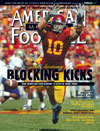AMERICAN FOOTBALL MONTHLY THE #1 RESOURCE FOR FOOTBALL COACHES
Article CategoriesAFM Magazine
|
The Speed Report: Minimize Training Time, Maximize Performanceby: Dale BaskettFootball Speed Specialist © More from this issue I’ve heard the concerns for years from football coaches that they only have a certain amount of time to implement new ingredients for their programs. Training year-round quite obviously can present challenges for fitting everything you want in place. I’ve discussed in speed training articles that team speed should be developed in phase increments (periodization). To train for speed you must plan for meeting the requirements necessary to get each player faster. My suggestion is to first analyze each athlete with test procedures. There’s not a weight room program in the country that doesn’t know the max amount each athlete lifts. Those numbers don’t tell the total story because dynamic strength and power on the field can vary because of the human movement involvement. The weight room numbers indicate the growth of power....The full article can only be seen by subscribers. Subscribe today!
|
|
|||||||
| HOME |
MAGAZINE |
SUBSCRIBE | ONLINE COLUMNISTS | COACHING VIDEOS |
Copyright 2025, AmericanFootballMonthly.com
All Rights Reserved





